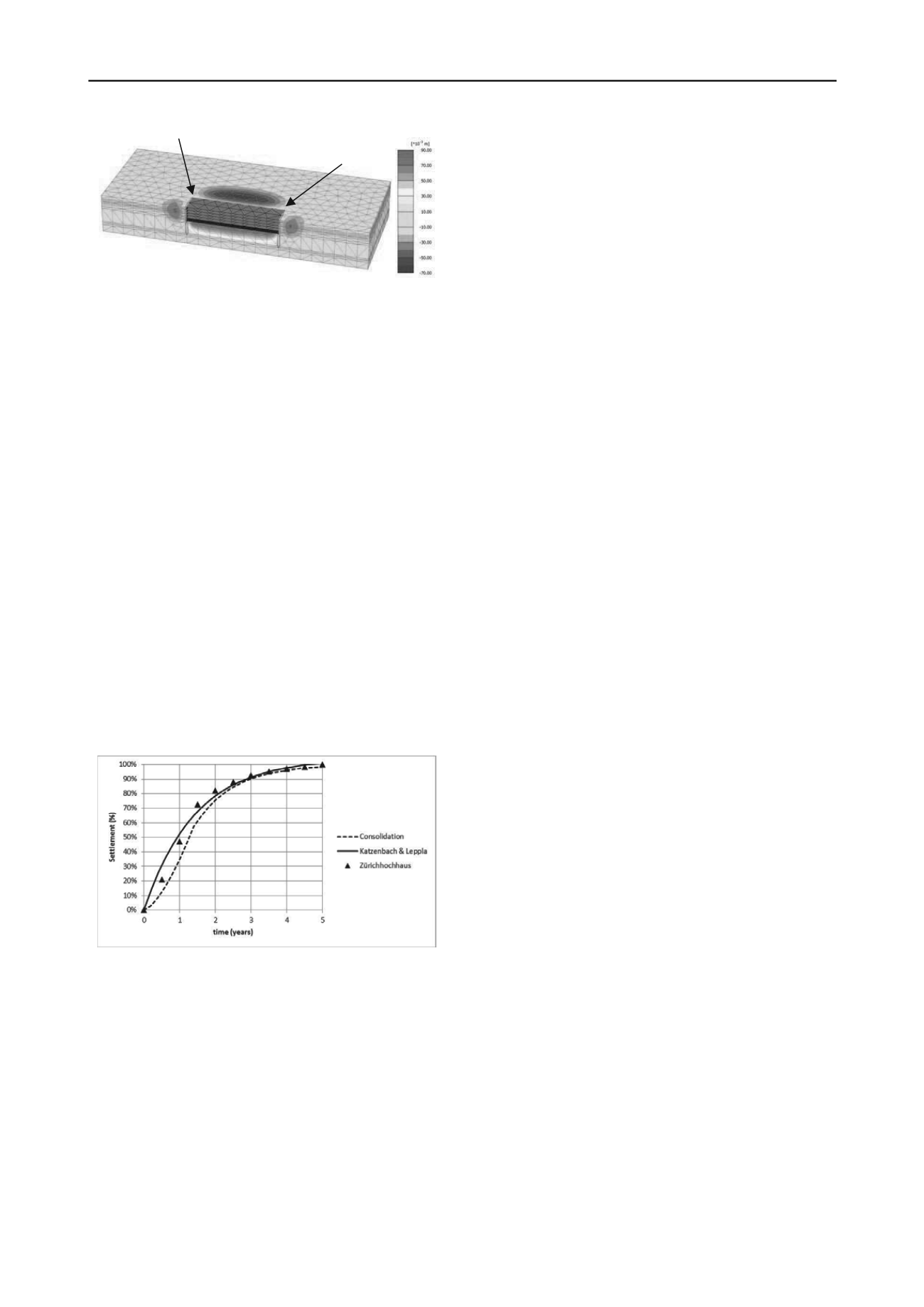
1917
Technical Committee 207 /
Comité technique 207
Figure 3. Settlements due to excavation (
Horn-Da Lin et al.
).
3.2 Loading and Unloading due to high rise buildings and
excavations
The paper presented by
R. Katzenbach and S. Leppla
presents results of ground heave and settlement measurements
due to excavations, building construction and de-construction.
This behavior, which could be expected not only in Frankfurt,
but also in other geological environments, was adequately
documented during a significant time period for some buildings.
The first important issue, often neglected due to lack of
reliable information, is the fact that unloading generates
significant upward movement, in the order of some or even
several cm.
The second issue is the time dependent behavior: a
significant part of total displacements are measured at the end of
construction, but between 30 and 50% of the observed behavior,
occur during months or years after completion of the
construction works.
Katzenbach and Leppla
propose an empirical equation to
represent this time dependent behavior. Just as an exercise,
Figure 4 presents monitoring results and the equation proposed
by
Katzenbach and Leppla
, and, additionally, settlements
estimated using conventional consolidation theory. A
consolidation coefficient at the recompression stage of c
v
= 9 x
10
-2
cm/s was backanalyzed from the measured settlements.
This value can be considered representative of overconsolidated
clays.
Figure 4. Settlement in % using conventional consolidation theory, the
equation proposed by Katzenbach & Leppla and monitoring results.
From the discussion above, it becomes clear that, especially
in urban environments, even for material considered relatively
stiff, time dependent behavior cannot be neglected, depending
of local geology.
4 BRIEF REVIEW OF PAPERS RELATED TO
RETAINING STRUCTURES
37 papers focusing on retaining structures were selected for this
session, 18 of them associated to case histories and 19 with
research results. A broad range of topics related to retaining
structures was presented.
M. Abramento et al.
present a case history from Brazil, of a
mixed retaining structure, reinforced earth at the top and
anchored wall at the bottom, in a geotechnical environment of
expansive soils. The case history includes laboratory tests of the
expansive soils and anchor pull out tests, demonstrating that
injection pressures have significant impact on anchor resistance.
Monitoring results of the retaining structure are also presented,
showing significant horizontal displacement of the reinforced
earth face, and negligible horizontal displacements of the
anchored stretch.
D. Alexiew and H. Hangen
discuss a case history from
Bulgaria, where reinforced earth structures were used as
retaining structures. Relatively steep, 1H:10V, and high, over 20
m, structures are presented; constructive details are included.
Design considerations, including seismic actions, are also
discussed.
S. Baghery
present the case history of the deep excavation, in
marl and weather marl, associated to the construction of the
“Tour Odeon” in Monaco. The excavation is more than 70 m
deep and the excavation is supported by anchors.
Ö. Bilgin and E. Mansour
discuss theoretical analysis of
sheet piles in expansive soils. For a typical sheet pile wall, 10 m
high and with an anchor level at 2,5 m, significant increases in
anchor reactions and bending moments occur, as swelling
pressure increases. Higher wall penetrations also become
necessary. Swelling pressures were associated to the Plasticity
Index and moisture content variations.
C. M. Chow and Y.C. Tan
. present data related the
performance of soil nails in weathered granite and fill. Several
soil nail pull out tests were performed in excavations up to 20 m
depth. Lateral friction measurement results varied between 50
and 140 KPa. A conservative correlation for lateral friction of 5
x SPT (in KPa) blowcount is also proposed.
I.P. Damians et al
. discuss the influence of vertical facing
stiffness on reinforced soil wall design. Numerical results
showed that the loads at the base of the vertical facing and in
the reinforcement are affected by the backfill and foundation
material, and that the face stiffness also affects reinforcement
tensile forces.
T. Durgunoglu et al.
present a case history from Turkey, an
over 20 m deep excavation close to the Bosphorus. Top down
construction method was used, including excavation of rock
sockets into rock with a uniaxial compressive strength varying
between less than 10 MPa, up to almost 100 MPa.
R.J. Finno et al.
discuss ground movements due to top-down
construction in Chicago. For this type of construction,
according to these authors, normalized horizontal movements of
0,15% to 0,2% are expected. Approximately 40% of these
movements can be attributed to time dependent behavior of the
concrete slabs. Significant movements can be associated to
activities other than the excavation, like potholing.
R. Frischknecht et al.
present an environmental impact
evaluation, comparing a conventional concrete structure with a
geosynthetic reinforced earth structure. The conclusion of the
evaluation is that geosynthetic retaining structure shows a 63%
to 87% lower environmental impact.
P.P. Ganne and X. Raucroix
discuss the design of cantilever
walls with a relief floor. For unsaturated, sandy, silty and
alluvial clayey soils, an analytical design methodology is
proposed, including pre-design recommendations.
A. Gomes Correia et al.
present a case history of a 13 m high
CSM anchored retaining wall built in Portugal. The CSM wall
was built in fill, sands and weathered sandstone, reinforced by
steel beams with a horizontal spacing of 1,1m. Maximum
measured horizontal displacements were of 16 mm.
A. Guilloux et al.
discuss the design, modeling and
monitoring of the Tour Odeon, also presented by
Baghery
. A
3D numerical model is presented as main design tool. The use
of the observational model with a maximum horizontal
displacement of 17 mm is described.
E. Guler et al.
present the case history of a 23 m deep
excavation in Istanbul. 2D and 3D numerical modeling was
used to evaluate interaction between 2 tunnels, a circular shaft
and a deep braced excavation. 2D and 3D models were
compared and the 2D analysis showed results on the safe side.
Monitoring results obtained during construction yielded reduced


